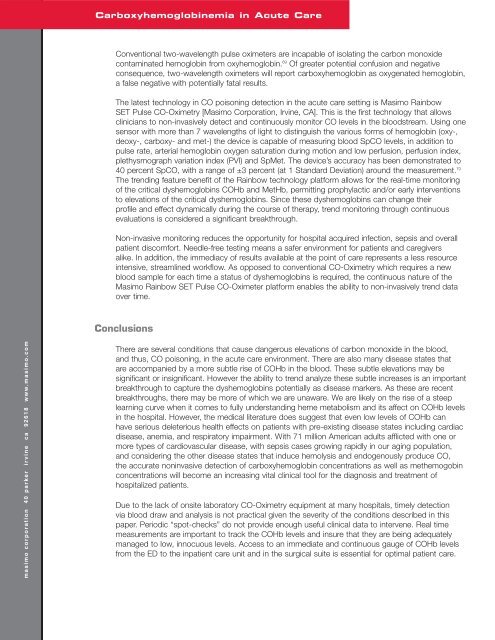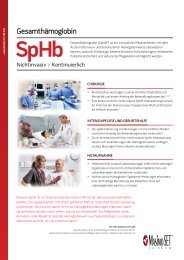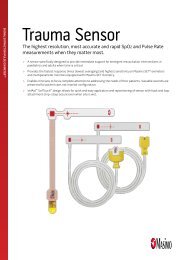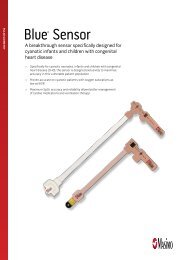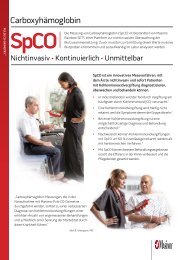Carboxyhemoglobin - Masimo
Carboxyhemoglobin - Masimo
Carboxyhemoglobin - Masimo
You also want an ePaper? Increase the reach of your titles
YUMPU automatically turns print PDFs into web optimized ePapers that Google loves.
masimo corporation 40 parker irvine ca 92618 www.masimo.com<br />
<strong>Carboxyhemoglobin</strong>emia in Acute Care<br />
Conventional two-wavelength pulse oximeters are incapable of isolating the carbon monoxide<br />
contaminated hemoglobin from oxyhemoglobin. 69 Of greater potential confusion and negative<br />
consequence, two-wavelength oximeters will report carboxyhemoglobin as oxygenated hemoglobin,<br />
a false negative with potentially fatal results.<br />
The latest technology in CO poisoning detection in the acute care setting is <strong>Masimo</strong> Rainbow<br />
SET Pulse CO-Oximetry [<strong>Masimo</strong> Corporation, Irvine, CA]. This is the first technology that allows<br />
clinicians to non-invasively detect and continuously monitor CO levels in the bloodstream. Using one<br />
sensor with more than 7 wavelengths of light to distinguish the various forms of hemoglobin (oxy-,<br />
deoxy-, carboxy- and met-) the device is capable of measuring blood SpCO levels, in addition to<br />
pulse rate, arterial hemoglobin oxygen saturation during motion and low perfusion, perfusion index,<br />
plethysmograph variation index (PVI) and SpMet. The device’s accuracy has been demonstrated to<br />
40 percent SpCO, with a range of ±3 percent (at 1 Standard Deviation) around the measurement. 70<br />
The trending feature benefit of the Rainbow technology platform allows for the real-time monitoring<br />
of the critical dyshemoglobins COHb and MetHb, permitting prophylactic and/or early interventions<br />
to elevations of the critical dyshemoglobins. Since these dyshemoglobins can change their<br />
profile and effect dynamically during the course of therapy, trend monitoring through continuous<br />
evaluations is considered a significant breakthrough.<br />
Non-invasive monitoring reduces the opportunity for hospital acquired infection, sepsis and overall<br />
patient discomfort. Needle-free testing means a safer environment for patients and caregivers<br />
alike. In addition, the immediacy of results available at the point of care represents a less resource<br />
intensive, streamlined workflow. As opposed to conventional CO-Oximetry which requires a new<br />
blood sample for each time a status of dyshemoglobins is required, the continuous nature of the<br />
<strong>Masimo</strong> Rainbow SET Pulse CO-Oximeter platform enables the ability to non-invasively trend data<br />
over time.<br />
Conclusions<br />
There are several conditions that cause dangerous elevations of carbon monoxide in the blood,<br />
and thus, CO poisoning, in the acute care environment. There are also many disease states that<br />
are accompanied by a more subtle rise of COHb in the blood. These subtle elevations may be<br />
significant or insignificant. However the ability to trend analyze these subtle increases is an important<br />
breakthrough to capture the dyshemoglobins potentially as disease markers. As these are recent<br />
breakthroughs, there may be more of which we are unaware. We are likely on the rise of a steep<br />
learning curve when it comes to fully understanding heme metabolism and its affect on COHb levels<br />
in the hospital. However, the medical literature does suggest that even low levels of COHb can<br />
have serious deleterious health effects on patients with pre-existing disease states including cardiac<br />
disease, anemia, and respiratory impairment. With 71 million American adults afflicted with one or<br />
more types of cardiovascular disease, with sepsis cases growing rapidly in our aging population,<br />
and considering the other disease states that induce hemolysis and endogenously produce CO,<br />
the accurate noninvasive detection of carboxyhemoglobin concentrations as well as methemogobin<br />
concentrations will become an increasing vital clinical tool for the diagnosis and treatment of<br />
hospitalized patients.<br />
Due to the lack of onsite laboratory CO-Oximetry equipment at many hospitals, timely detection<br />
via blood draw and analysis is not practical given the severity of the conditions described in this<br />
paper. Periodic “spot-checks” do not provide enough useful clinical data to intervene. Real time<br />
measurements are important to track the COHb levels and insure that they are being adequately<br />
managed to low, innocuous levels. Access to an immediate and continuous gauge of COHb levels<br />
from the ED to the inpatient care unit and in the surgical suite is essential for optimal patient care.


